Calibration Experiment and Temperature Compensation Method for the Thermal Output of Electrical Resistance Strain Gauges in Health Monitoring of Structures
Abstract
1. Introduction
2. Principle of Thermal Output of Electrical Resistance Strain Gauges
2.1. Measurement Principle of Electrical Resistance Strain Gauges
2.2. Coupled Thermo-Electro-Elasticity Equations
2.3. Elastic Constitutive Relation
3. Temperature Calibration Experiments for Different Measured Materials
3.1. Zero-Drift Experiment
3.2. Calibration Experiments for the Thermal Output of Different Measured Materials
3.3. Calculation of the Thermal Output for Different Measured Materials
3.4. Coupled Deformation Analysis of Strain Gauges and Measured Materials
3.5. Analysis of the Error Caused by the Thickness of an Adhesive Layer
4. Conversion Relationship of Strain Gauge Thermal Output for Different Materials
4.1. Calculation Principle
4.2. Calculation Example
5. Conclusions
- (1)
- The thermal output curves applicable to different materials were obtained based on temperature calibration tests conducted on a variety of materials. The thermal output shows a linear relationship with temperature, and the thermal output compensation value at each temperature can be calculated according to the thermal output fitting formula.
- (2)
- When the coefficient of linear expansion of the measured material is larger or much smaller than that of the strain gauge grating material, the two thermal output curves show an opposite trend. This means that when the coefficient of linear expansion of the measured material is larger than that of the strain gauge grating material, the elongation of the strain gauges is promoted, and thus, the thermal output during the temperature change is increased. When the coefficient of linear expansion of the measured material is smaller than that of the strain gauge grating material, the elongation of the strain gauges is prevented, and thus, the thermal output decreases.
- (3)
- The thickness of the adhesive layer between the strain gauge and the measured object affects the thermal output. The thermal output of the strain gauge increases significantly when the thickness of the adhesive layer is in the range of 0.5 to 2 mm. When the thickness of the adhesive layer reaches 2 mm, the increase in the thermal output of the strain gauge is no longer significant. This difference is relatively small within 20 °C but becomes increasingly larger as the temperature increases.
- (4)
- The thermal output conversion relationships were derived for materials with different linear expansion coefficients. The thermal output of material B was estimated from the thermal output of material A and the linear expansion coefficients of the two materials (A and B), and the maximum difference between the estimated and actual values was within 10% in the range of 10 °C to 50 °C.
Author Contributions
Funding
Data Availability Statement
Conflicts of Interest
References
- Tegtmeier, F.L. Strain gauge based microsensor for stress analysis in building structures. Measurement 2008, 41, 1144–1151. [Google Scholar] [CrossRef]
- Yang, Y. Special Issue Editorial “Symmetry in Structural Health Monitoring”. Symmetry 2022, 14, 1211. [Google Scholar] [CrossRef]
- Lei, J.; Kong, Q.; Wang, X.; Zhan, K. Strain Monitoring-Based Fatigue Assessment and Remaining Life Prediction of Stiff Hangers in Highway Arch Bridge. Symmetry 2022, 14, 2501. [Google Scholar] [CrossRef]
- Ding, M.; Shen, Y.; Wei, Y.; Luo, B.; Wang, L.; Zhang, N. Preliminary Design and Experimental Study of a Steel-Batten Ribbed Cable Dome. Symmetry 2021, 13, 2136. [Google Scholar] [CrossRef]
- Shi, G.; Liu, Z.; Meng, X.; Wang, Z. Intelligent Health Monitoring of Cable Network Structures Based on Fusion of Twin Simulation and Sensory Data. Symmetry 2023, 15, 425. [Google Scholar] [CrossRef]
- Wang, T.; Shi, B.; Zhu, Y. Structural Monitoring and Performance Assessment of Shield Tunnels during the Operation Period, Based on Distributed Optical-Fiber Sensors. Symmetry 2019, 11, 940. [Google Scholar] [CrossRef]
- Jin, Z.H.; Li, Y.; Li, Q.W.; Liu, Z.B.; Wu, S.B.; Wang, Z. Modification of the CSIRO method in the long-term monitoring of slope-induced stress. Front. Earth Sci. 2022, 10, 981470. [Google Scholar] [CrossRef]
- Xia, Y.; Chen, B.; Weng, S.; Ni, Y.Q.; Xu, Y.L. Temperature effect on vibration properties of civil structures: A literature review and case studies. J. Civ. Struct. Health Monit. 2012, 2, 29–46. [Google Scholar] [CrossRef]
- Kromanis, R.; Kripakaran, P. SHM of bridges: Characterising thermal response and detecting anomaly events using a temperature-based measurement interpretation approach. J. Civ. Struct. Health Monit. 2016, 6, 237–254. [Google Scholar] [CrossRef]
- Liu, X.; Kang, F.; Ma, C.B.; Li, H.J. Concrete arch dam behavior prediction using kernel-extreme learning machines considering thermal effect. J. Civ. Struct. Health Monit. 2021, 11, 283–299. [Google Scholar] [CrossRef]
- Zhao, H.W.; Ding, Y.L.; Li, A.Q.; Chen, B.; Wang, K.P. Digital modeling approach of distributional mapping from structural temperature field to temperature-induced strain field for bridges. J. Civ. Struct. Health Monit. 2022, 13, 251–267. [Google Scholar] [CrossRef]
- Hoffmann, K. An Introduction to Measurements Using Strain Gages; Hottinger Baldwin Messtechnik GmbH: Darmstadt, Germany, 1989; p. 257. [Google Scholar]
- John, N.F. Measurement of thermal expansion coefficients using a strain gauge. Am. J. Phys. 1990, 58, 875. [Google Scholar]
- Cappa, P.; Rita, G.D.; McConnell, K.G.; Zachary, L.W. Using strain gages to measure both strain and temperature. Exp. Mech. 1992, 32, 230–233. [Google Scholar] [CrossRef]
- Richards, W.L. A new correction technique for strain-gage measurements acquired in transient-temperature environments. In NASA Technical Reports Server (NTRS); Edwards: California, CA, USA, 1996; p. 3593. [Google Scholar]
- Batten, M.; Powrie, W.; Boorman, R.; Yu, H.T.; Leiper, Q. Use of vibrating wire strain gauges to measure loads in tubular steel props supporting deep retaining walls. Proc. Inst. Civ. Eng.-Geotech. Eng. 1999, 137, 3–13. [Google Scholar] [CrossRef]
- Cappa, P.; Marinozzi, F.; Sciuto, S.A. The “strain-gauge thermocouple”: A novel device for simultaneous strain and temperature measurement. Rev. Sci. Instrum. 2001, 72, 193–197. [Google Scholar] [CrossRef]
- Rodrigues, C.; Félix, C.; Lage, A.; Figueiras, J. Development of a long-term monitoring system based on FBG sensors applied to concrete bridges. Eng. Struct. 2010, 32, 1993–2002. [Google Scholar] [CrossRef]
- Aiyeh, E. Thermal Output and Thermal Compensation Models for Apparent Strain in a Structural Health Monitoring-Based Environment. Master’s Thesis, University of Manitoba, Winnipeg, Manitoba, 2012. [Google Scholar]
- Zhao, Y.; Liu, Y.; Li, Y.; Hao, Q. Development and application of resistance strain force sensors. Sensors 2020, 20, 5826. [Google Scholar] [CrossRef]
- Neild, S.A.; Williams, M.S.; McFadden, P.D. Development of a vibrating wire strain gauge for measuring small strains in concrete beams. Strain 2005, 41, 3–9. [Google Scholar] [CrossRef]
- Chen, C.; Wang, Z.; Wang, Y.; Wang, T.; Luo, Z. Reliability assessment for PSC box-girder bridges based on SHM strain measurements. J. Sens. 2017, 2017, 8613659. [Google Scholar] [CrossRef]
- Prakash, G.; Sadhu, A.; Narasimhan, S.; Brehe, J.M. Initial service life data towards structural health monitoring of a concrete arch dam. Struct. Control Health Monit. 2018, 25, e2036. [Google Scholar] [CrossRef]
- Litoš, P.; Švantner, M.; Honner, M. Simulation of strain gauge thermal effects during residual stress hole drilling measurements. J. Strain Anal. Eng. Des. 2005, 40, 611–619. [Google Scholar] [CrossRef]
- Kieffer, T.P.; Peters, K.J. The effect of short range order on the thermal output and gage factor of Ni3FeCr strain gages. Strain 2017, 54, e12253. [Google Scholar] [CrossRef]
- Xiao, X.; Li, H.X.; Cui, H.Z.; Bao, X.H. Evaluation of thermal-drift effect on strain measurement of energy pile. Constr. Build. Mater. 2023, 362, 129663. [Google Scholar] [CrossRef]
- Gomes, P.T.V.; Maia, N.S.; Mansur, T.R.; Palma, E.S. Temperature effect on strain measurement by using weldable electrical resistance strain gages. J. Test. Eval. 2003, 31, 363–369. [Google Scholar]
- Yu, G.; Elshafie, M.Z.E.B.; Dirar, S.; Middleton, C.R. The response of embedded strain sensors in concrete beams subjected to thermal loading. Constr. Build. Mater. 2014, 70, 279–290. [Google Scholar] [CrossRef]
- Ye, C.; Butler, L.J.; Elshafie, M.Z.E.B.; Middleton, C.R. Evaluating prestress losses in a prestressed concrete girder railway bridge using distributed and discrete fibre optic sensors. Constr. Build. Mater. 2020, 247, 118518. [Google Scholar] [CrossRef]
- Clauß, F.; Ahrens, M.A.; Mark, P. A comparative evaluation of strain measurement techniques in reinforced concrete structures–A discussion of assembly, application, and accuracy. Struct. Concr. 2021, 22, 2992–3007. [Google Scholar] [CrossRef]
- Mohamad, H. Distributed Optical Fibre Strain Sensing of Geotechnical Structures. Ph.D. Thesis, Universiti Teknologi Petronas, Seri Iskandar, Malaysia, 2008. [Google Scholar]
- Li, Y.; Fu, S.S.; Qiao, L.; Liu, Z.B.; Zhang, Y.H. Development of twin temperature compensation and high-level biaxial pressurization calibration techniques for CSIRO in-situ stress measurement in depth. Rock Mech. Rock Eng. 2019, 52, 1115–1131. [Google Scholar] [CrossRef]
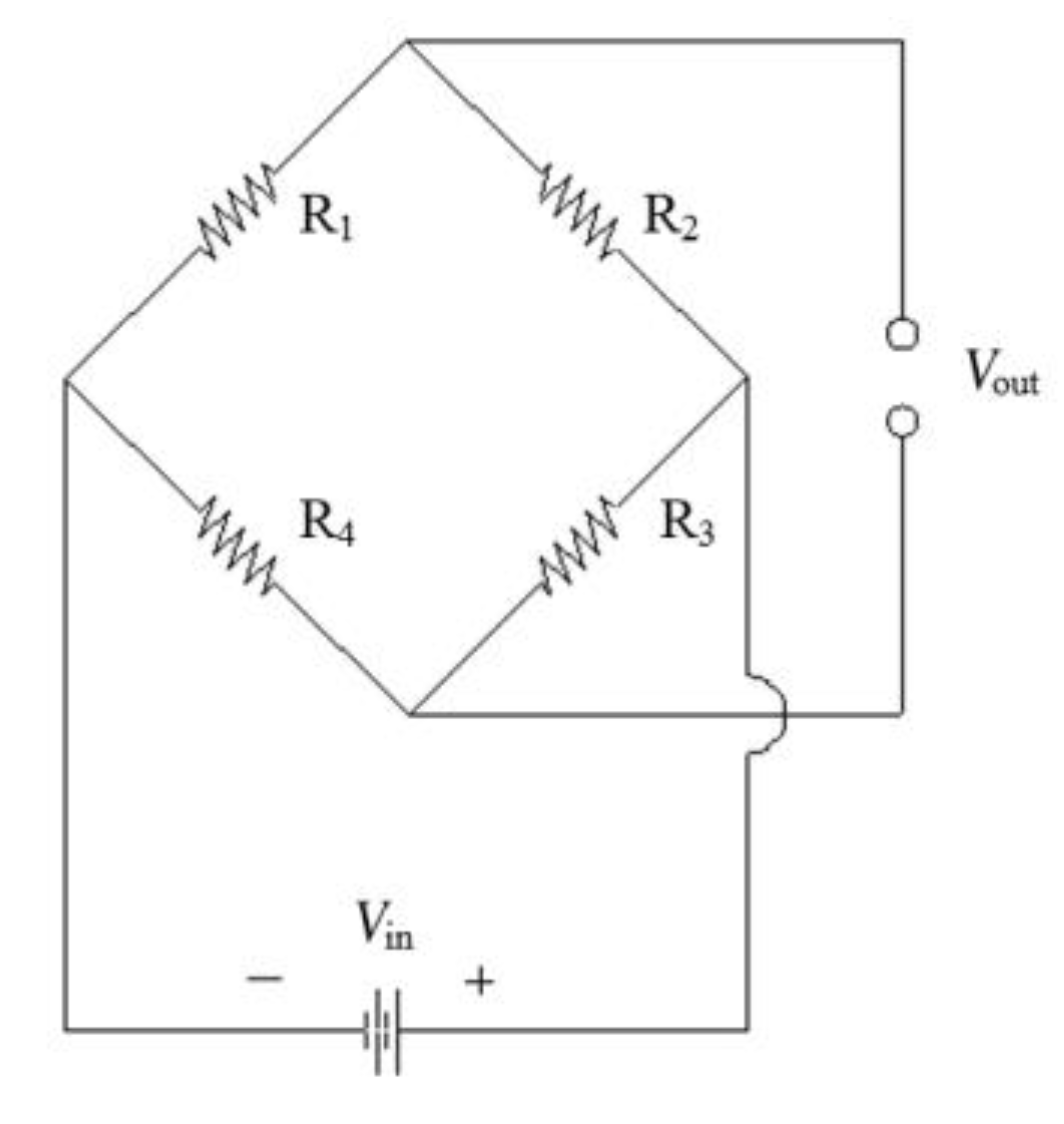
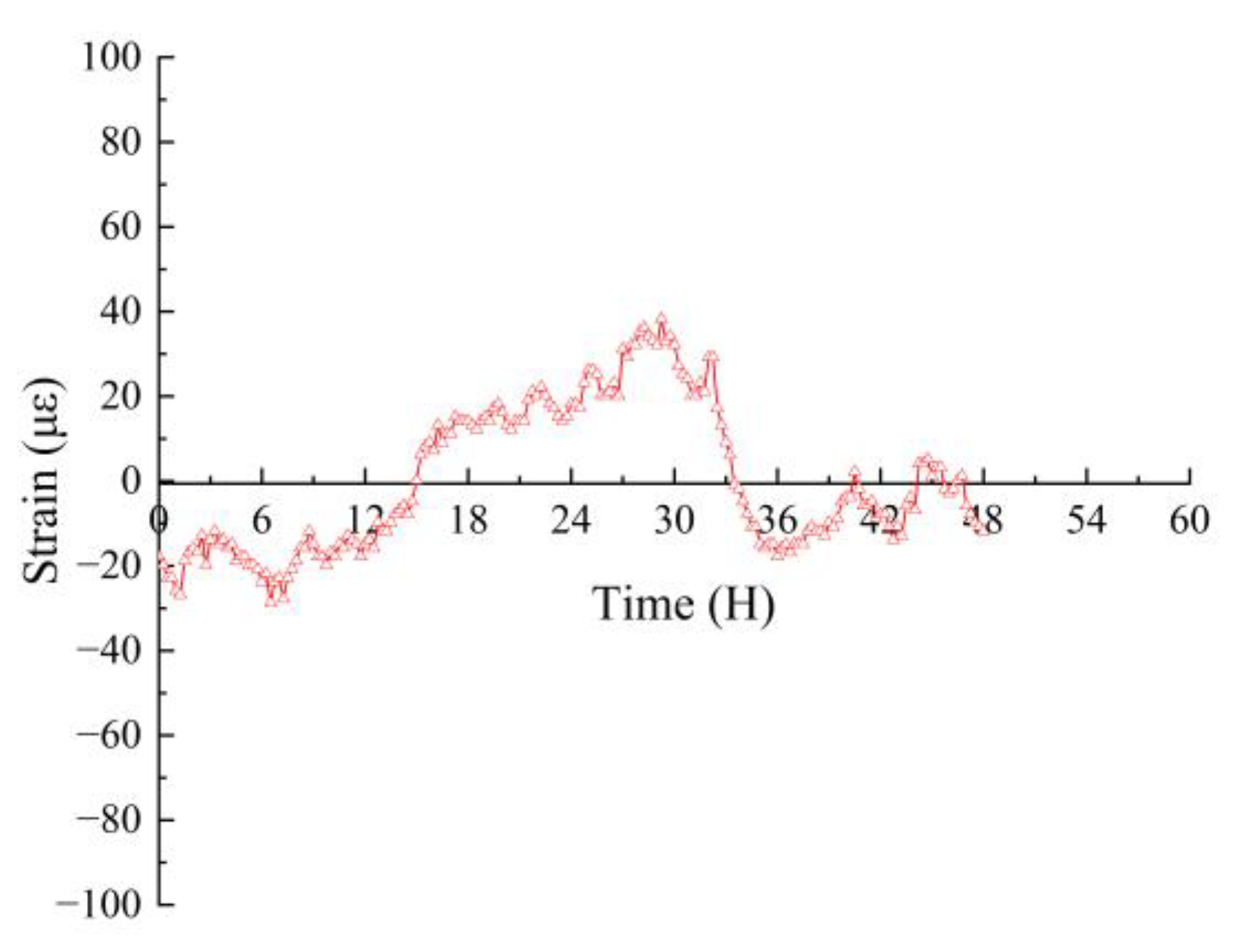
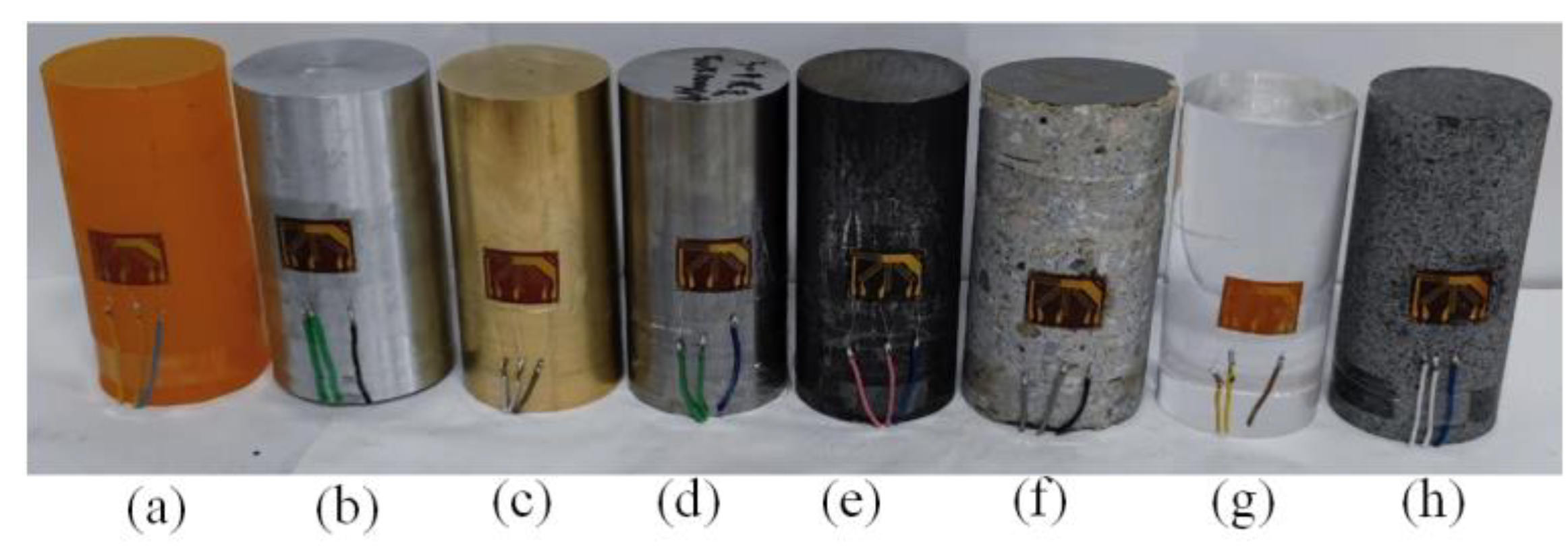
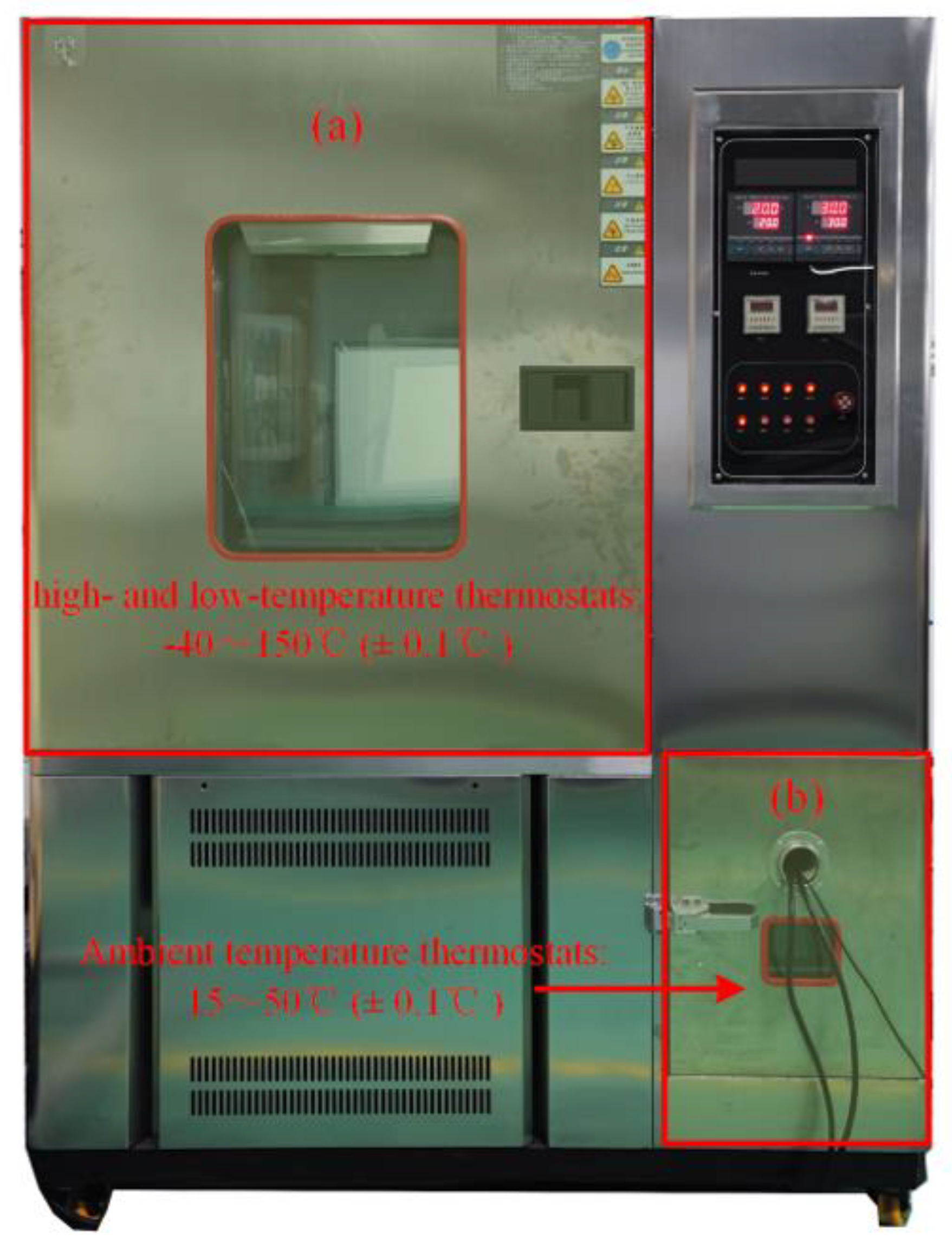
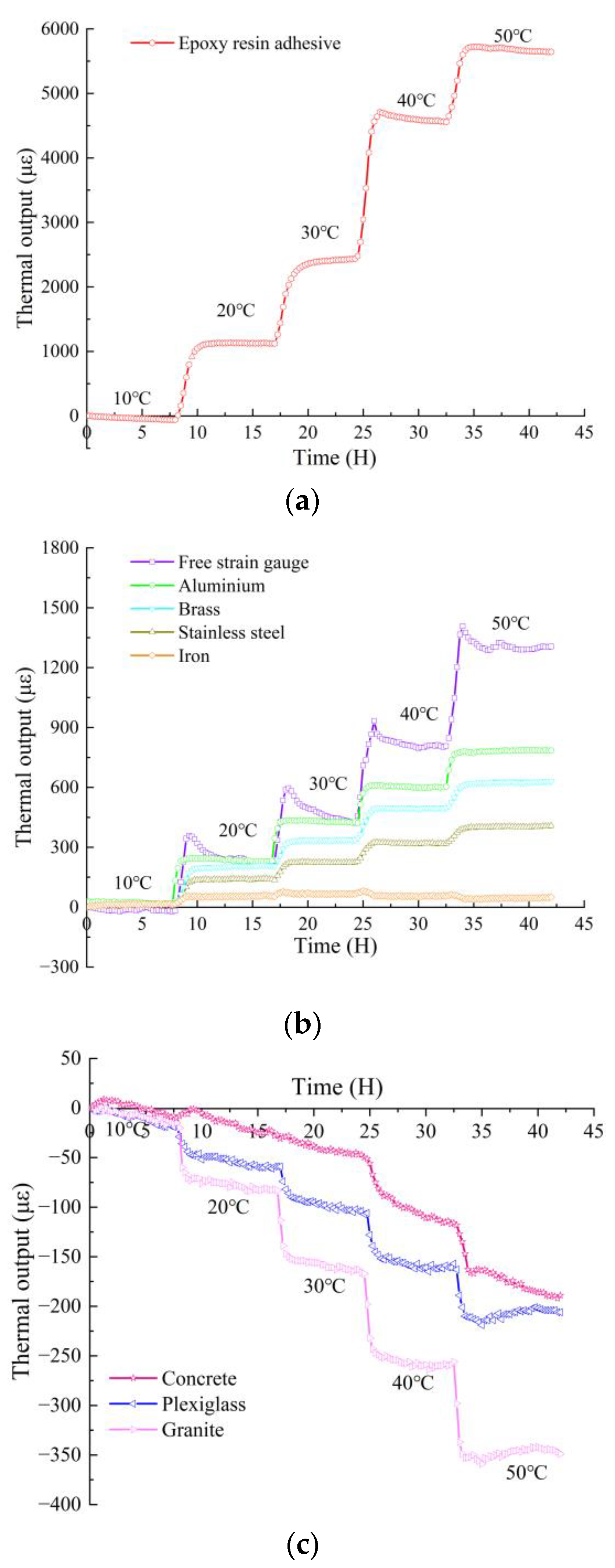

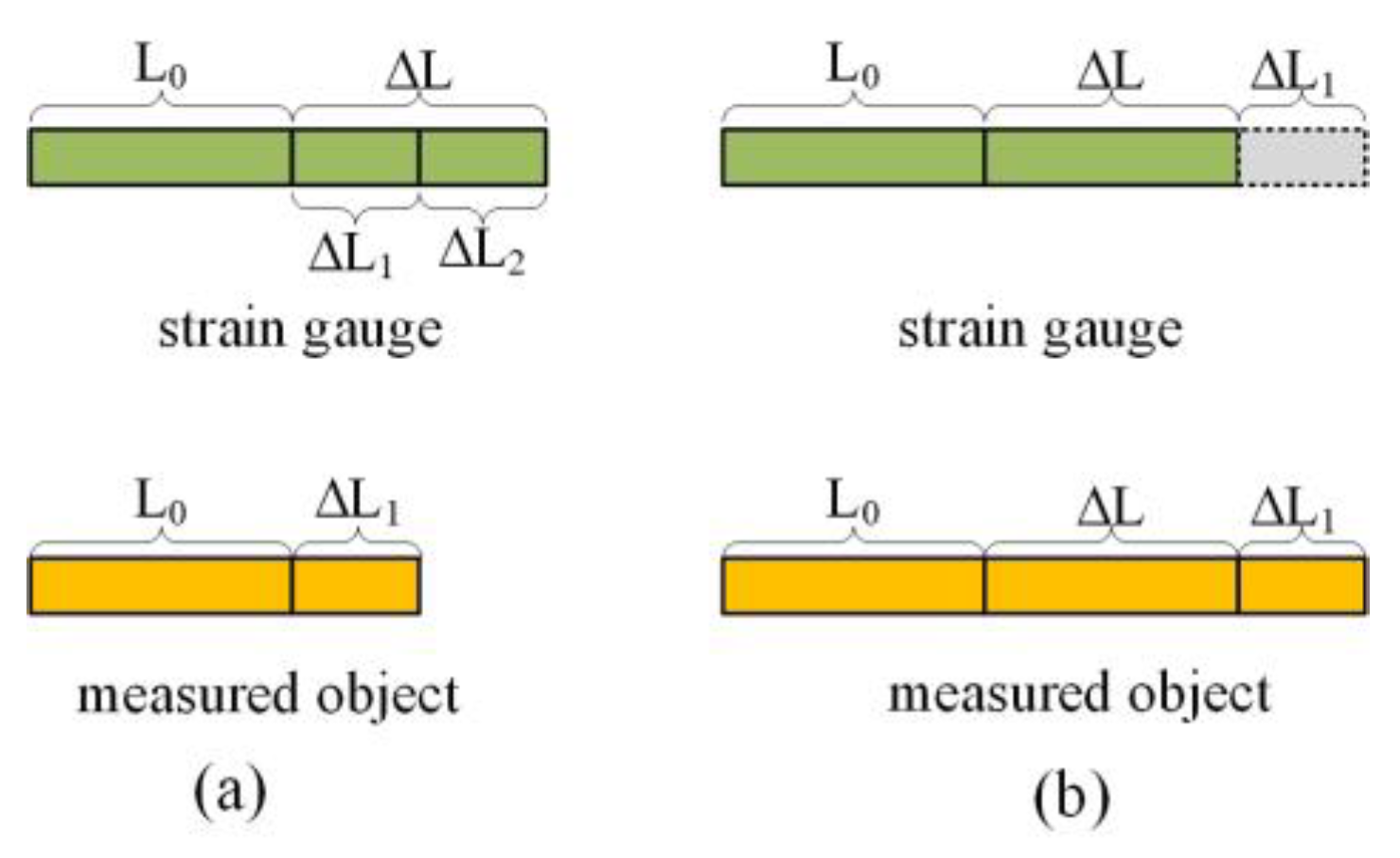
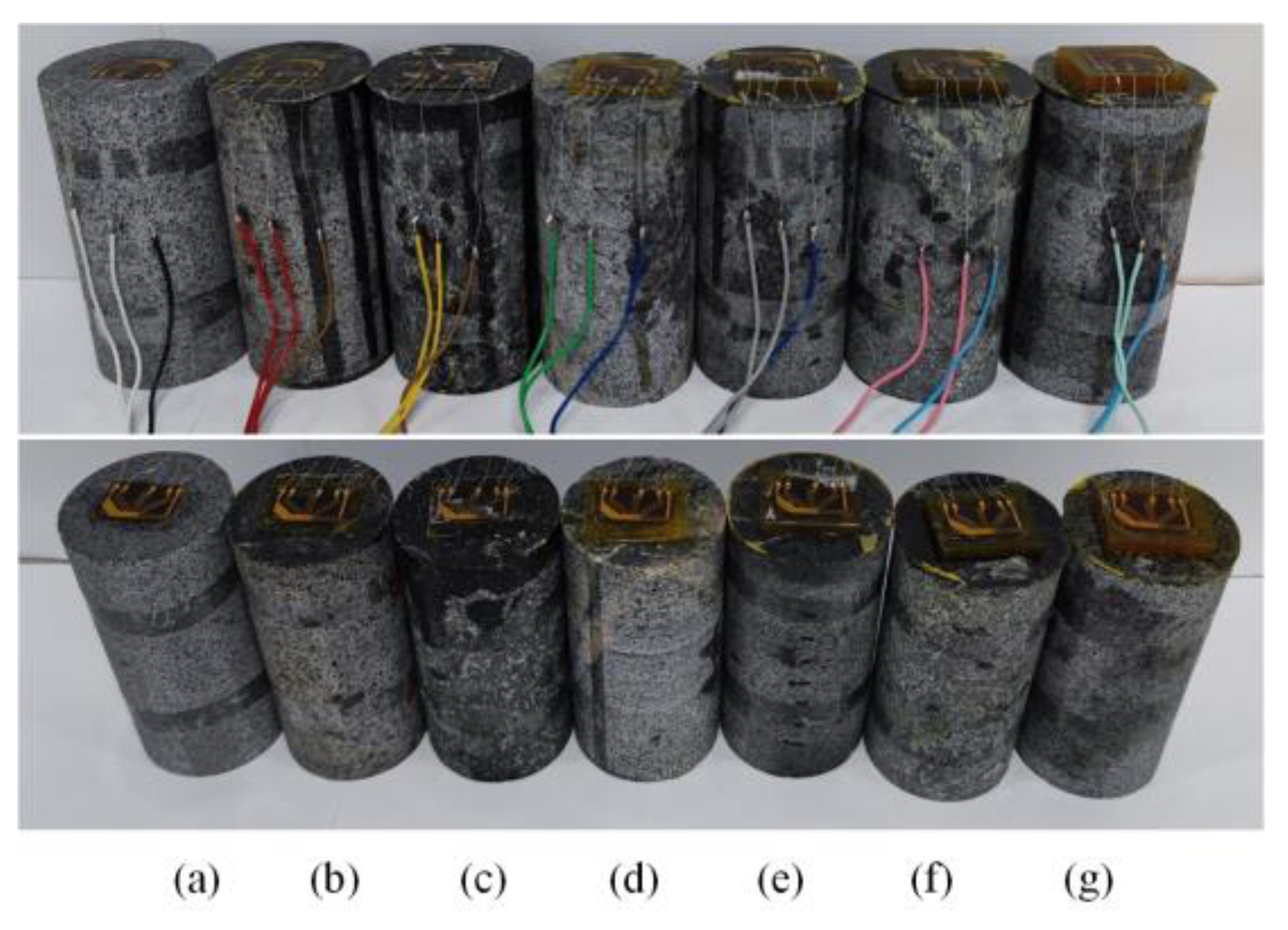
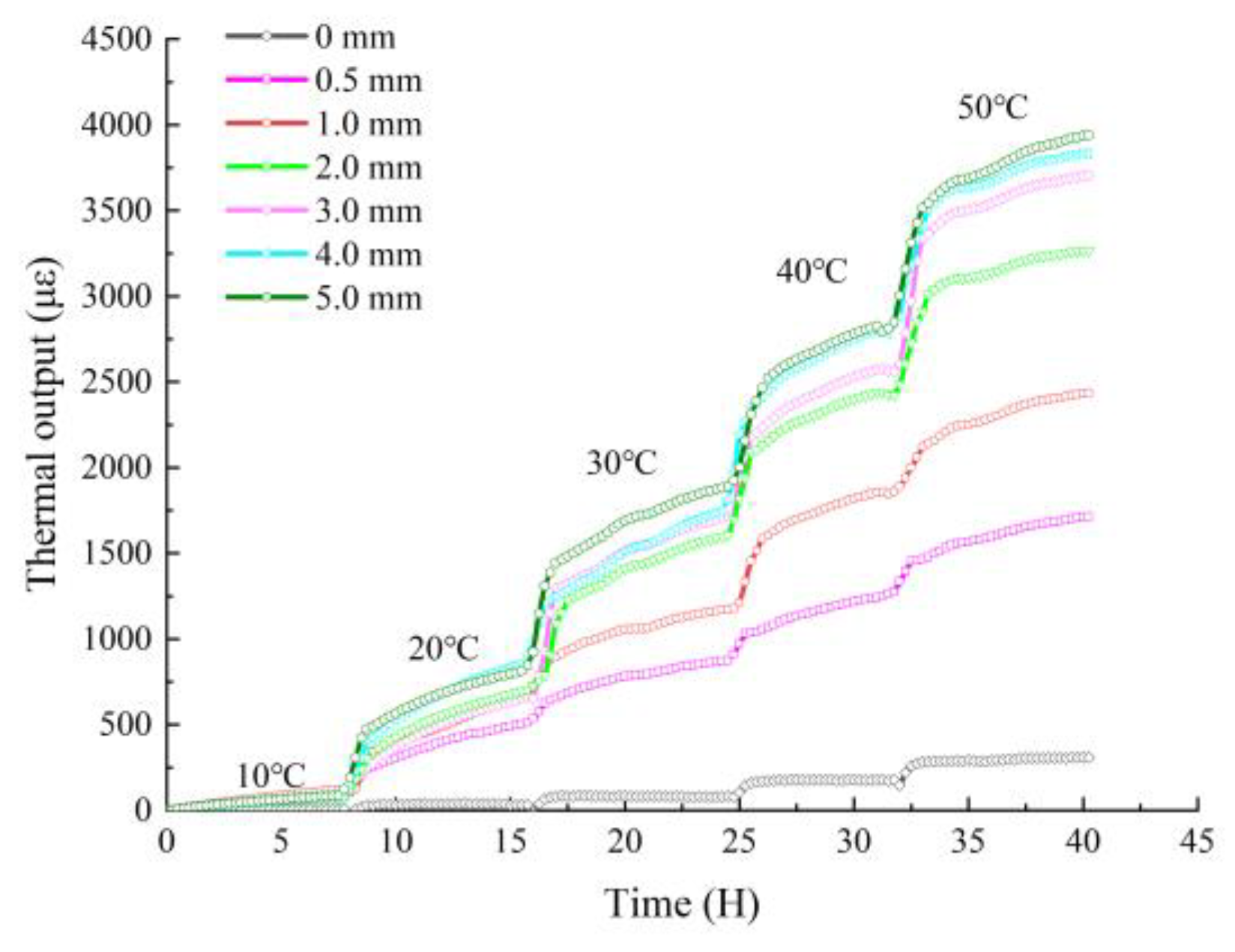
| T/°C | Epoxy Resin Adhesive | Free Strain Gauge | Aluminum | Brass | Stainless Steel | Iron | Concrete | Plexiglass | Granite |
|---|---|---|---|---|---|---|---|---|---|
| 10 | −34 | −12 | 25 | 15 | 10 | 14 | 2 | −7 | −7 |
| 20 | 1128 | 245 | 242 | 202 | 138 | 53 | −14 | −51 | −76 |
| 30 | 2359 | 497 | 435 | 337 | 227 | 71 | −38 | −95 | −156 |
| 40 | 4636 | 825 | 607 | 495 | 319 | 55 | −101 | −156 | −257 |
| 50 | 5711 | 1295 | 778 | 622 | 400 | 43 | −166 | −214 | −352 |
| T/°C | ΔT/°C | ||||
|---|---|---|---|---|---|
| 10 | 0 | / | / | / | / |
| 20 | 10 | 202 | 256 | 242 | 5.8% |
| 30 | 20 | 337 | 445 | 435 | 2.3% |
| 40 | 30 | 495 | 657 | 607 | 8.2% |
| 50 | 40 | 622 | 838 | 778 | 7.7% |
Disclaimer/Publisher’s Note: The statements, opinions and data contained in all publications are solely those of the individual author(s) and contributor(s) and not of MDPI and/or the editor(s). MDPI and/or the editor(s) disclaim responsibility for any injury to people or property resulting from any ideas, methods, instructions or products referred to in the content. |
© 2023 by the authors. Licensee MDPI, Basel, Switzerland. This article is an open access article distributed under the terms and conditions of the Creative Commons Attribution (CC BY) license (https://creativecommons.org/licenses/by/4.0/).
Share and Cite
Jin, Z.; Li, Y.; Fan, D.; Tu, C.; Wang, X.; Dang, S. Calibration Experiment and Temperature Compensation Method for the Thermal Output of Electrical Resistance Strain Gauges in Health Monitoring of Structures. Symmetry 2023, 15, 1066. https://doi.org/10.3390/sym15051066
Jin Z, Li Y, Fan D, Tu C, Wang X, Dang S. Calibration Experiment and Temperature Compensation Method for the Thermal Output of Electrical Resistance Strain Gauges in Health Monitoring of Structures. Symmetry. 2023; 15(5):1066. https://doi.org/10.3390/sym15051066
Chicago/Turabian StyleJin, Zhihao, Yuan Li, Dongjue Fan, Caitao Tu, Xuchen Wang, and Shiyong Dang. 2023. "Calibration Experiment and Temperature Compensation Method for the Thermal Output of Electrical Resistance Strain Gauges in Health Monitoring of Structures" Symmetry 15, no. 5: 1066. https://doi.org/10.3390/sym15051066
APA StyleJin, Z., Li, Y., Fan, D., Tu, C., Wang, X., & Dang, S. (2023). Calibration Experiment and Temperature Compensation Method for the Thermal Output of Electrical Resistance Strain Gauges in Health Monitoring of Structures. Symmetry, 15(5), 1066. https://doi.org/10.3390/sym15051066







